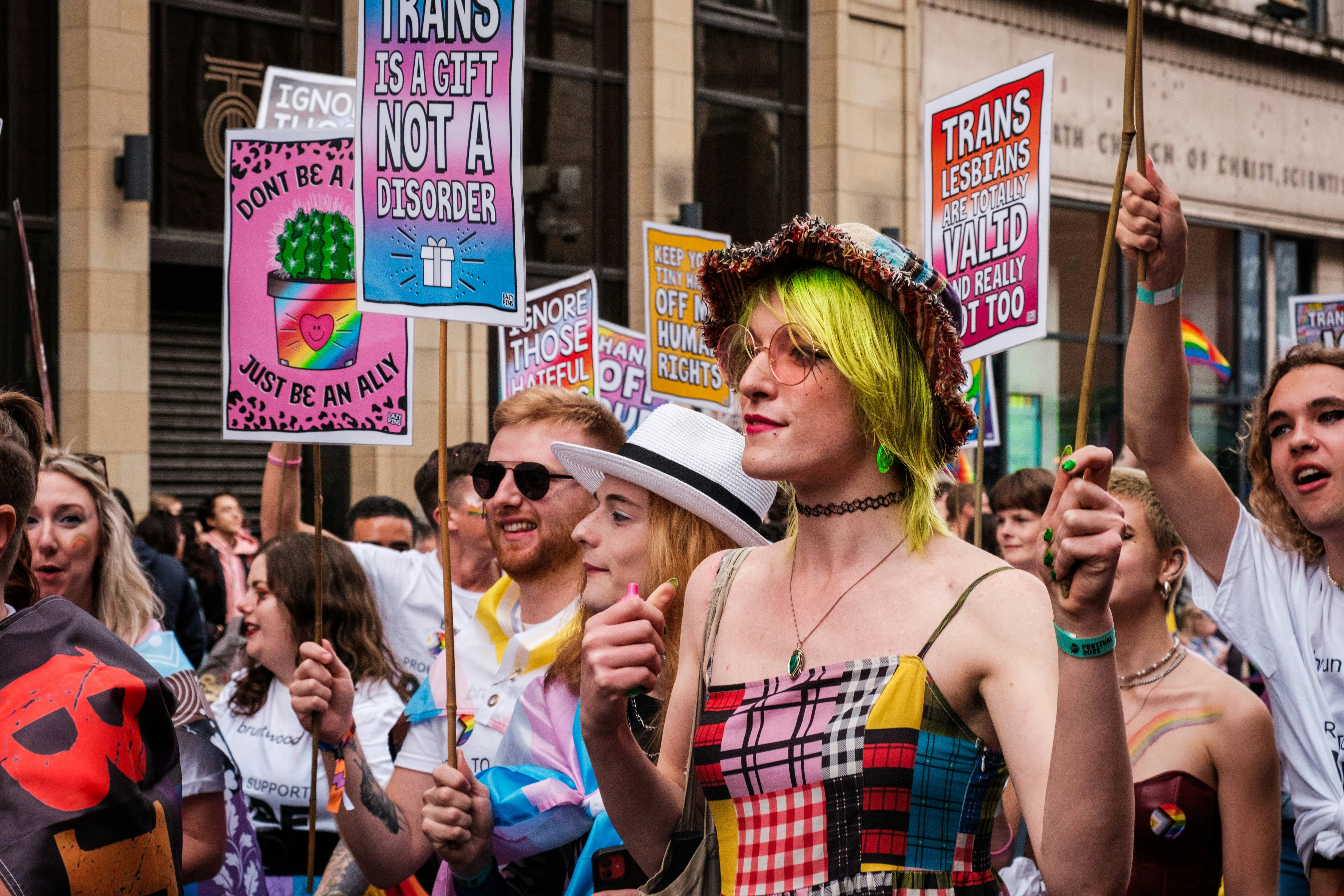Understanding Transgender Transitions: A Nuanced Perspective

What is a Transgender Woman?
A transgender woman is an individual who was assigned male at birth but identifies and lives as a woman. This definition is rooted in the broader concept of gender identity, which refers to an individual’s personal sense of their gender, which may be different from the sex assigned to them at birth. Gender identity is distinct from biological sex, which encompasses physical characteristics such as chromosomes, hormone levels, and reproductive/sexual anatomy.
Understanding the identity of a transgender woman involves the interplay of several essential terminologies. For instance, the term ‘transgender’ is an umbrella descriptor that includes individuals whose gender identity or expression differs from the sex they were assigned at birth. In contrast, ‘cisgender’ refers to individuals whose gender identity aligns with their assigned sex. Additionally, the process of gender transition varies significantly among individuals, and it may involve social, medical, and legal changes. Social transition might include adopting a new name, pronouns, and presentation consistent with one’s gender identity.
For many transgender women, their identity has profound personal and societal implications. Experiencing gender dysphoria, the distress or discomfort that arises from a disconnect between gender identity and assigned sex, can influence various aspects of life including mental health and social interactions. Despite facing significant challenges such as discrimination and stigma, many transgender women find empowerment and community through their identity. Supportive environments play a crucial role in fostering acceptance and understanding, allowing transgender women to navigate their lives more freely, and highlighting the importance of respect for individual identity and experiences.
The Journey from Male to Female: Transitioning as a Transgender Woman
The journey of transitioning from male to female as a transgender woman encompasses various significant steps that involve physical, emotional, and social changes. One of the primary medical interventions is hormone replacement therapy (HRT), which allows individuals to develop physical characteristics aligned with their gender identity. During this process, transgender women typically receive estrogen and anti-androgens to promote breast development, redistribution of body fat, and softer skin. HRT can lead to profound changes, enabling individuals to feel more comfortable in their bodies.
In addition to HRT, many transgender women may consider various surgical options to enhance their transition. These procedures can include breast augmentation, facial feminization surgery, and gender confirmation surgery—often referred to as sex reassignment surgery. Each of these surgeries aims to create physical attributes that align with an individual’s gender identity, further promoting psychological well-being. Nevertheless, the decision to pursue surgery is deeply personal and varies significantly among individuals; not all transgender women choose to undergo surgical procedures.
The emotional and psychological aspects of transitioning are equally vital. Transgender individuals often navigate complex feelings of dysphoria—discomfort arising from the discrepancy between their gender identity and assigned sex at birth. Support systems, counseling, and peer support groups play crucial roles in helping transgender women manage these emotional challenges. Facing societal responses, including stigma and discrimination, can also impact mental health, underscoring the importance of social acceptance and understanding. Despite these challenges, many find empowerment and fulfillment in their transitions, leading to a more authentic life that aligns with their true selves.
The Female-to-Male Transition: Understanding Transgender Men
The transition from female to male is a multifaceted process that encompasses a variety of aspects including hormone replacement therapy (HRT), surgical interventions, and the personal motivations that drive individuals to embrace their authentic gender identity as transgender men. HRT typically involves the administration of testosterone, which facilitates physical changes aimed at masculinization. These changes may include the deepening of the voice, increased body hair growth, facial hair development, and alterations in fat distribution. The effects of testosterone can vary significantly among individuals, depending on genetic factors, age, and duration of treatment.
Surgical options further enhance the transition experience for many transgender men. Common procedures may include chest masculinization surgery, which aims to create a male-contoured chest and eliminate breast tissue, and various forms of genital surgery, such as phalloplasty or metoidioplasty. These surgeries are vital for some individuals as they align physical appearance with gender identity, thus contributing to an improved quality of life and mental well-being.
The motivations for transitioning are deeply personal and can stem from a desire to alleviate gender dysphoria, achieve greater alignment with one’s identity, and enhance overall mental health. Understanding these motivations is crucial for fostering empathy and support for transgender men within society. Furthermore, there exist numerous societal misconceptions about transgender men, including stereotypes that undermine the legitimacy of their identity. It is important to recognize that the experiences of transgender men are unique and valid, reinforcing the need for education and awareness. By acknowledging the complexities of the female-to-male transition, society can move towards a more inclusive environment that honors the lived experiences of transgender individuals.
Mental Health Considerations in the Transition Process
The journey of transitioning genders is not solely a physical transformation; it is an intricate process that profoundly influences mental health. Gender dysphoria, characterized by a heightened sense of discomfort or distress associated with one’s assigned sex at birth, often leads individuals to seek a transition as a means of achieving greater alignment with their true identity. However, navigating the transition process can evoke a spectrum of mental health challenges that require careful attention and support.
One significant concern is the prevalence of anxiety and depression experienced by individuals grappling with gender dysphoria. The dissonance between one’s gender identity and societal expectations can lead to feelings of isolation and alienation. As individuals approach the transition process, it is crucial for them to engage with mental health professionals who are knowledgeable about gender issues. These professionals can provide a safe space for exploration and help devise strategies for managing the psychological complexities that may arise during this transformative journey.
Further, the process of transitioning does not come without its risks; some individuals may face regret concerning their decisions, which can be emotionally taxing. Mental health support becomes essential in helping them navigate these feelings of doubt or remorse, ensuring they feel validated in their experiences. Support groups and counseling can facilitate healthy discussions, providing a sense of community and understanding amidst the emotional turbulence.
Additionally, the potential effects of societal stigma and discrimination should not be overlooked. These harsh realities can exacerbate mental health issues and contribute to the risk of suicidal ideation among transgender individuals. Thus, it is imperative that mental health support systems are readily accessible, addressing these multifaceted concerns as individuals traverse the complexities of gender transition.
The Role of Support Systems in the Transition Process
Support systems play a crucial role in the process of gender transition for transgender individuals. These systems often comprise family, friends, professionals, and the wider community, all of whom can contribute significantly to the emotional and practical aspects of transitioning. Research has consistently shown that having strong support networks can lead to better mental health outcomes for transgender individuals. These networks can provide understanding, acceptance, and reassurance, which are vital during such a pivotal life change.
Family members, for example, can offer a safe space for individuals exploring their gender identity. Acceptance from loved ones can greatly reduce the stress and anxiety associated with transitioning. Friends often help by affirming the individual’s gender identity and encouraging their personal journey. Moreover, professionals such as therapists or support groups provide invaluable guidance. They can equip transgender individuals with tools to navigate societal challenges and personal struggles, making the transition smoother.
Conversely, it is essential to recognize potential drawbacks associated with support systems. In some instances, excessive enabling or uncritical acceptance can arise, which may unintentionally hinder an individual’s transition. For instance, support that does not encourage self-reflection or critical evaluation of the transition process may lead to unpreparedness in facing the realities of societal discrimination or personal challenges. It is crucial for support systems to strike a balance, ensuring they provide affirmation while also fostering understanding of the complexities involved in gender identity and expression.
In summary, the role of support systems is instrumental in the transition process for transgender individuals. While the presence of supportive family, friends, and professionals can significantly enhance the transition experience, it is essential for these networks to maintain a balance of encouragement and critical understanding of the intricacies involved. Such an approach can contribute to a healthier, more informed transition journey.
When Transitioning is Motivated by External Validation
The process of transgender transition is deeply personal and varies significantly from one individual to another. While many individuals pursue transition to align their external appearance with their internal identity, others may be motivated by external validation. This phenomenon can stem from societal pressures or the desire to gain acceptance and admiration from peers, family, or potential partners. Recognizing the distinction between transitioning for personal authenticity and for external validation is crucial in understanding the complexity of these motivations.
When an individual transitions primarily to meet external expectations, it raises concerns about their long-term happiness and well-being. This type of transition may occur due to a perceived obligation to conform to societal norms, where acceptance is contingent on aligning with specific gender roles or presentations. Individuals in this situation might feel compelled to make changes that do not authentically resonate with their true selves. Consequently, the risk of regret may increase, as their identity is influenced more by external opinions than by genuine self-discovery.
A desire to attract partners can also impact the decision to transition for external validation. In the quest for romantic relationships, some may believe that adopting a different gender presentation will yield a more favorable response in the dating sphere. While seeking validation and connection is a natural human tendency, basing one’s identity on the expectations of romantic partners or society at large can lead to significant psychological distress. Engaging in a transition for these external reasons may diminish one’s sense of identity and adversely affect self-esteem.
Ultimately, it is essential for individuals contemplating transition to reflect on their motivations. Engaging in a personal journey that prioritizes self-acceptance and authenticity can lead to a more fulfilling and sustainable experience. By approaching the transition process with a focus on internal desires rather than external validation, individuals are more likely to foster a sense of genuine identity and well-being throughout their journey.
The Reality of Gender Identity and the Concept of a ‘True Self’
Gender identity is a complex aspect of human existence that transcends mere biological determinism. It is a deeply personal experience shaped by various factors, including societal expectations, cultural influences, and individual psychological makeup. For many transgender individuals, embracing their authenticity is a significant component of their journey. This process often involves confronting and expressing what one might refer to as their ‘true self.’ However, the path to realizing this true self is not always linear and can be fraught with challenges.
One of the predominant difficulties faced by transgender individuals is the fatigue associated with constantly navigating societal expectations and norms. This fatigue can manifest in various ways, including stress and anxiety, which may lead to temporary deviations from their expressed identity. For instance, in a workplace setting, a transgender person may encounter pressures that compel them to conform to a more traditional gender presentation, despite their transitioned identity. Such situations can prompt individuals to adopt traits or behaviors that are incongruent with their true self, leading to internal conflict and emotional strain.
In social contexts, similar patterns can occur. Encounters with friends, family, or acquaintances who hold certain biases may influence how a transgender individual chooses to present themselves. This might manifest as an effort to avoid judgment or hostility, resulting in a performance that feels disingenuous. Over time, these repeated experiences can have a cumulative effect, contributing to a sense of disconnection from one’s authentic identity.
This intricate interplay between societal influence and personal authenticity reveals the nuanced nature of gender identity. Understanding these complexities is crucial for fostering empathy and support for transgender individuals as they navigate their transitions and seek to express their true selves authentically.
The Challenges of Navigating Gender Identity in the Workplace
Transgender individuals often face a myriad of challenges when navigating their gender identity in professional settings. Discrimination remains a critical issue, as studies consistently show that transgender employees can experience bias during hiring, promotion, or in everyday interactions with colleagues. This systemic discrimination can lead to feelings of isolation and discouragement among transgender workers, making it difficult for them to fully engage and succeed in their careers.
In addition to overt discrimination, microaggressions pose significant challenges. These subtle, often unintentional, comments or actions can undermine a transgender individual’s confidence and sense of belonging. For example, misgendering—using incorrect pronouns to reference a transgender person—can be a common occurrence that creates a hostile work environment. Such experiences can not only affect workplace morale but can also have lasting impacts on an individual’s mental health and overall job satisfaction.
Moreover, the pressure to conform to traditional gender norms adds another layer of complexity. Transgender employees may feel compelled to present themselves in ways that align with societal expectations, which can be emotionally taxing and detract from their authentic self-expression. The fear of backlash or ostracism can lead individuals to hide their identities, resulting in internal conflict and increased stress levels.
Creating inclusive workplace policies is crucial in addressing these challenges. Organizations that implement comprehensive anti-discrimination policies and provide diversity training foster an environment where transgender individuals can thrive. Additionally, establishing support networks, such as employee resource groups, can promote solidarity and offer essential resources. By prioritizing inclusivity and recognition of diverse gender identities, employers can enhance workplace cultures and improve the overall experience for transgender employees.
Navigating Acceptance and Understanding in Society
Societal attitudes toward transgender individuals have evolved considerably over recent decades. In the past, transgender people often faced significant discrimination, social stigma, and mental health challenges. Historically marginalized, they encountered barriers in various aspects of life, including employment, healthcare, and legal recognition. However, recent years have witnessed gradual progress toward acceptance and understanding, largely due to increased visibility and advocacy efforts.
One of the pivotal factors in this progress has been the rise of educational initiatives aimed at raising awareness of transgender issues. Schools, workplaces, and community organizations are increasingly prioritizing inclusivity training that highlights the importance of respecting diverse gender identities. Such educational programs foster understanding and empathy, helping to dismantle outdated stereotypes and misconceptions. Awareness campaigns have also played a crucial role, providing platforms for transgender individuals to share their experiences and challenges, thereby humanizing their journeys and fostering compassion within communities.
Despite these strides, many challenges remain. Transgender individuals still contend with systemic discrimination and violence globally, which can be exacerbated by political and social climates. Additionally, the discourse around transgender rights is often fraught with contention, reflective of broader societal conflicts over gender identity and expression. Advocacy remains vital in combating these issues, as activists strive for essential reforms in areas like healthcare access, legal protections, and educational support. By amplifying the voices of transgender individuals, advocates can inspire greater societal awareness and action.
Ultimately, a comprehensive understanding of transgender transitions necessitates continuous engagement with these topics. The journey toward inclusivity is ongoing, requiring sustained effort in education and advocacy to create a society where all gender identities are respected and embraced. Collaboration among various sectors—educators, policymakers, and community members—is essential in cultivating a culture that fosters acceptance and understanding.
Tags: transitioning services






